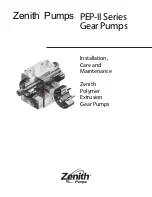
PCRP
3
OUTLET
PRIME PLUG
HOSE
ADAPTERS
INLET
Figure 2
4. Figure 2 shows a typical installation. Threaded adapters are
furnished for attaching garden hose where conditions permit its
use. In no case should the pump be more than 15 feet above
or away from water source. Install a foot valve when suction lift
is over 10 feet or when suction line is over 10 feet long.
5. The inlet line may be galvanized pipe, plastic pipe, or reinforced
hose. Small leaks in suction line
greatly
reduce efficiency of
pump and may prevent priming.
Ordinary garden hose WILL collapse under
suction pressure and SHOULD NOT be used for
the inlet line, except in pressure boosting applications.
6. Use a strainer when pumping from a creek, pond, or source
where foreign objects may be sucked into the pump. The
strainer should prevent solids from entering the inlet line.
7. A regular garden hose may be used as a discharge line.
OPERATION
Pump must be filled with water before
operation. Running the pump dry WILL cause
damage to the shaft seal.
1. This unit is
not
waterproof or weatherproof and is
not
intended to be used in showers, saunas, or other potentially
wet locations. The motor is designed to be used in a clean,
dry location with access to adequate cooling air. Ambient
temperatures around the motor should not exceed 104˚F (40˚C).
2. Remove priming plug and fill with water. Replace plug (plumbers
seal tape should be used on priming plug to prevent air leaks).
3. Plug power cord into GFCI protected electrical outlet. The
pump will prime in a few minutes depending on suction line
length. Use of foot valve on suction line is recommended.
4. In the case of pressure boosting, turn water on before starting
pump. This force primes the pump. Then, plug power cord into
GFCI protected electrical outlet.
5. Unplug cord to turn unit off.
MAINTENANCE
Let pump cool for at least 20 minutes before
attempting to service. Motor MAY be extremely
hot. Personal injury MAY result.
1. Pump should be checked periodically for proper operation.
ALWAYS disconnect the electrical supply before
attempting to operate, service, or perform any
maintenance. If the power source is out of sight, lock and tag in the open
(off) position to prevent unexpected power application. Failure to do so
WILL result in fatal electrical shock. Only qualified electricians SHOULD
repair this unit. Improper repair WILL result in fatal electrical shock.
BRUSH REPLACEMENT
Brushes for this pump SHOULD be inspected
after 100 hours of operation.
Pumps with excess of 100 hours of operation may stop operating
or fail to start. This could be due to worn brushes or carbon build-
up. The brushes should be removed and carbon removed. Worn
brushes are not covered under warranty. Replacement brushes may
be available from RIDGID. Call 1-877-9RIDGID to order.
1) Disconnect electrical cord from power supply.
2) Remove brush caps with screwdriver.
3) Remove old brush assembly.
4) Replace brushes, make sure springs do not pinch during
assembly. Align/center tabs on the back of the brush spring
with the flats on the brush hlder. REF. fig3.
5) Replace brush caps.
For other problems, consult troubleshooting chart.
Содержание RIDGID PCRP
Страница 7: ...PCRP 7 NOTES ...
Страница 15: ...PCRP Sp 15 NOTAS ...


































